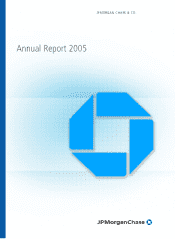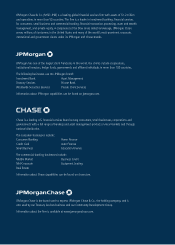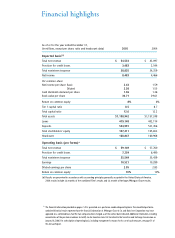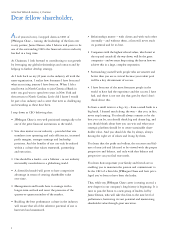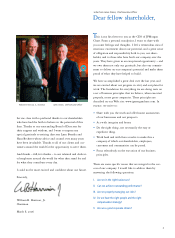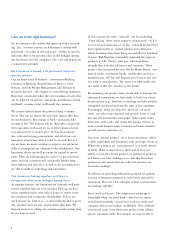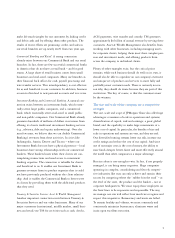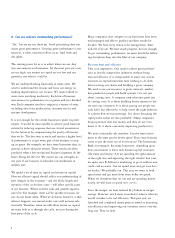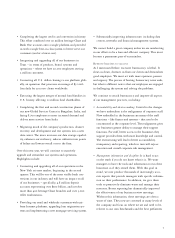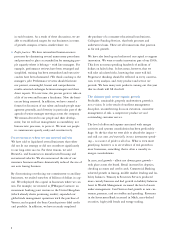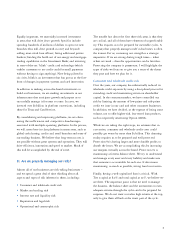JP Morgan Chase 2005 Annual Report Download - page 11
Download and view the complete annual report
Please find page 11 of the 2005 JP Morgan Chase annual report below. You can navigate through the pages in the report by either clicking on the pages listed below, or by using the keyword search tool below to find specific information within the annual report.
9
Equally important, we materially increased investment
in areas that will drive future growth. Specifics include:
spending hundreds of millions of dollars to open new
branches (this will drive growth in and beyond);
adding more retail loan officers; hiring additional private
bankers; funding the build-out of our energy and mortgage
trading capabilities in the Investment Bank; and investing
in state-of-the-art “blink” credit card technology (which
enables customers to use credit cards for small payments
without having to sign anything). Now being piloted in
six cities, blink is an investment that has put us at the fore-
front of changes in payment systems and card innovation.
In addition to making across-the-board investments to
build our businesses, we are making investments in our
infrastructure that anticipate growth and prepare us to
successfully manage it for years to come. In , we
invested over $billion in platform conversions, including
those for Texas and Card Services.
By consolidating and improving platforms, we are elimi-
nating the inefficiencies and competitive disadvantages
associated with multiple operating platforms. In the process,
we will create best-in-class platforms in many areas, such as
global cash clearing, credit card, retail branches and some of
our trading business. We believe that long-term success is
not possible without great systems and operations. They will
drive efficiency, innovation and speed to market. Much of
this will be accomplished by the end of .
III. Are we properly managing our risks?
Almost all of our businesses are risk-taking businesses –
and we spend a great deal of time thinking about all
aspects and types of risk inherent in them, including:
•Consumer and wholesale credit risk
•Market and trading risk
•Interest rate and liquidity risk
•Reputation and legal risk
•Operational and catastrophic risk
The notable fact about the first three risk areas is that they
are cyclical, and all of them have elements of unpredictabil-
ity. This requires us to be prepared for inevitable cycles. A
company that properly manages itself in bad times is often
the winner. For us, sustaining our strength is a strategic
imperative. If we are strong during tough times – when
others are weak – then the opportunities can be limitless.
Protecting the company is paramount. I will highlight the
types of risks we focus on to give you a sense of the threat
they pose and how we plan for it.
Consumer and wholesale credit risk
Over the years, our company has substantially reduced its
wholesale credit exposure by using a disciplined process for
extending credit and maximizing return on shareholder
capital. In the consumer market, we have controlled our
risk by limiting the amount of low-prime and sub-prime
credit we issue in our card and other consumer businesses.
In addition, we have decided, at the expense of losing some
volume, not to offer higher-risk, less-tested loan products,
such as negatively amortizing Option ARMs.
While we are taking the right steps, we estimate that in
arecession, consumer and wholesale credit costs could
possibly get worse by more than $billion. This daunting
reality requires us to be prepared and well protected.
Protection #is having larger and more durable profits to
absorb the losses. We are accomplishing this by increasing
our margins virtually across the board. Protection #is
maintaining a fortress balance sheet. We try to understand
and manage every asset and every liability and make sure
that someone is accountable for each one. It also means
maintaining, as much as possible, strong loan loss reserves.
Finally,having a well-capitalized firm is critical. With
Tier capital at .%and total capital at %, we believe we
are there. The important point is that we need to manage
the business, the balance sheet and the investments to earn
adequate returns through the cycles and to be prepared for
surprises. We do not want to realize high returns at the top,
only to give them all back at the worst part of the cycle.

